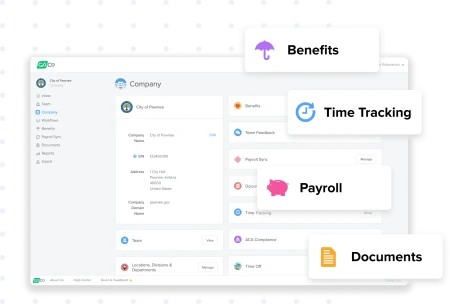What HR Professionals Need To Know About Form W-2
Everything HR pros need to know about the W-2 form!
July 21st, 2022
Whether you're new to HR or a veteran, you understand how much paperwork you have to deal with on a daily basis. One misfile or non-compliant form and the legal ramifications could be severe. With specific paperwork, the consequences aren't only felt by the company or HR but also by the employee.
Since all employees file taxes, employers must provide employees with a W-2 Wage and Tax Statement. Failure to provide employees with a W-2 can result in the employee delaying the filing of their taxes and your company facing fines from the IRS.
Keep reading to learn everything you need to know to complete and file the W-2 form correctly, and read HR's Guide to Compliance to learn about more compliance issues.
What Is a W-2 Tax Form?
The W-2 provides employees with needed tax filing information like wages and taxes withheld. Employers must send W-2 tax forms to employees and the IRS at the end of the year. The deadline is January 31.
The law requires and enforces deadlines to allow ample time for employees to file their taxes. The deadline for filing taxes in most situations is April 15.
The W-2 might not be issued to every person on a company’s payroll. Issue the form W-2 to those employees earning wages, salaries, or tips. But, any freelance and contract employees should be issued a 1099-MISC.
Use the form 1099 for any income or earnings not reported on a W-2. This includes bank account interest (1099-INT), investment dividends (1099-DIV), and retirement account dividends (1099-R).
Both the W-2 and the form 1099 are used to complete a tax return like Form 1040.
What Is Included in a Form for W-2?
The W-2 tax form divides into two sections: the lettered and numbered boxes. The lettered boxes contain identifying information for the employer and employee. The numbered boxes contain wages and taxes withheld.
However, as an HR professional, you must ensure the correct information is being entered into the right location.
Lettered Boxes
Boxes A through F is pretty straightforward. You will be able to transcribe most of the information from the employee's W4. However, it may be a good idea to take this time to ensure all employees' personal information is up-to-date.
Along with the employees' personal information, the employer's address and EIN are also required on the W-2. An EIN, or Employer Identification Number, gets assigned to businesses by the IRS. An EIN, also known as a Federal Tax Identification Number, identifies the business to the IRS.
It is the responsibility of the business to apply for an EIN or request an existing one using a 147c letter.
Numbered Boxes
The numbered boxes contain all the information employees need to file their taxes at the end of the year. Numbered 1-20, this is where you will list the employee's total earnings for the year in regular wages, social security wages, and medicare wages.
Employers also require the amount of tax held for the year for federal income tax, social security tax, and medicare tax.
The employer will also need to report local and state taxes to the state. This information, including the state the employee is working in, is at the bottom of the form.
Filing the W-2
As mentioned, employers must send the W-2 to employees before January 31. However, there is more to filing a W-2 than handing out a copy to the employee and mailing one to the IRS.
There are six copies HR professionals need to file for the W-2:
Copy A goes to the Social Security Administration by email or mail
Copy 1 (if required) goes to the employer's local tax department
Copies B, C, and 2 are all sent to the employee
The employer keeps copy D for at least four years
The IRS governs the proper distribution of the W-2 tax form and provides instructions on how to complete the form online.
Common Errors
When it comes to HR, paperwork almost really does only count in horseshoes. Each form must be filled out and filed correctly to avoid serious fines and penalties.
Some common mistakes with payroll that can muck up a W-2 include:
Improperly classifying of employees as contractors
Failure to withhold federal and state taxes
Late filings and tax payments
Terrible record keeping
That last error can lead to real trouble. Records are crucial for both the IRS and HRs. There are certain documents HR professionals must keep for a specific time frame.
For W-2, employers must keep a record of each employee's W-2 for at least four years. Records can be either a hard copy on or off-site or electronic. It is beneficial to ensure the records are easily searchable and retrievable to avoid lengthy audits.
COVID-19 Updates
Three types of paid sick or family leave wages must be reported in box 14 of the W-2. If unable to provide information in box 14, then the employer must provide a separate written statement along with the W-2.
The three types of paid sick or family leave are:
Sick leave due to employee needing care
Sick leave due to the employee providing care to others
Emergency family leave wages
If you provide a separate statement with the W-2 to the IRS, you must also include the statement with copies of the employees' W-2 forms.
Form W-2 and You
Nothing can mess up your week in HR more than finding out a W-2 tax form was filed incorrectly or contained incorrect information.
Understanding the W-2 tax form, how to complete it, and how to file it will make your HR tasks that much easier. W-2s are required for each employee who is not a contractor or self-employed and must be filed by January 31.
To keep on top of your HR needs, take a tour of GoCo today and see our top-rated HR solution in action. Let GoCo meet your HR needs and help ease some of your stress.

Subscribe to Beyond The Desk to get insights, important dates, and a healthy dose of HR fun straight to your inbox.
Subscribe hereRecommended Posts
What is a W-4 Form? How to Fill it Out & 2024 Changes
Blog Articles
Search...
Product
GoCo
Resources
Articles
eBooks
Webinars
Customer Stories

![Why is HR Compliance Important in 2024? [+Free Checklist]](/img/containers/assets/goco/featured_images/posts/the-importance-of-hr-compliance.png/b73096df7f78bcf9874200ba0eaccf0a.png)
![Complete 2024 HR Compliance Calendar and Important Deadlines [+Download]](/img/containers/assets/goco/featured_images/posts/2024compliancecalendar-2.png/fd610000def14287c5dae38bf0b4ed97.png)

